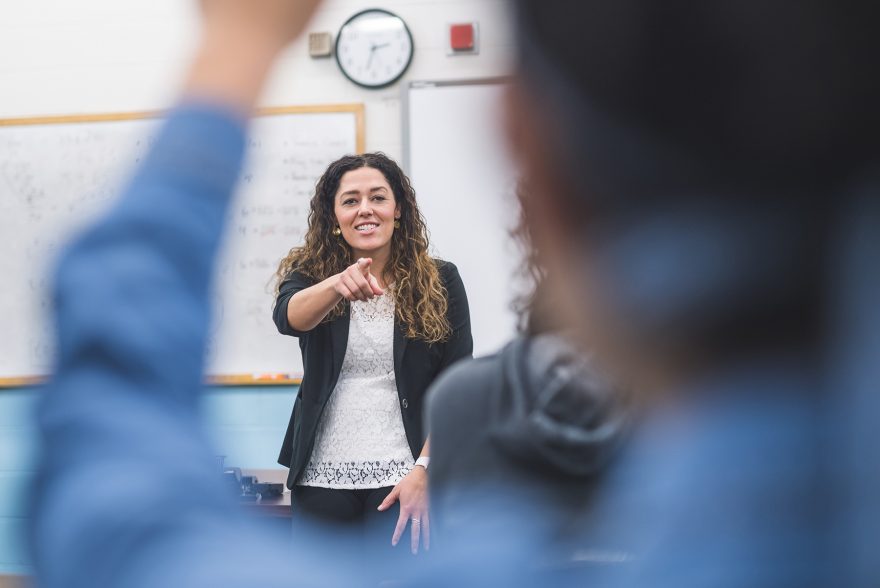How Common Are Instructional Coaches in Schools?

Instructional coaches can play a critical role in school systems. They help teachers with day-to-day challenges in the classroom, and many of them also coordinate on broader academic strategy with administrators in the central office.
Recently released federal data sheds light on the extent to which school districts are making use of instructional coaches in core academic subjects.
The data offers insights to education companies working with schools, who often need the support of instructional coaches to implement curriculum, professional development, classroom assessments and other products. Nurturing productive relationships with coaches is also important because of those educators’ roles as conduits between teachers and administrators.
The federal data was collected by the National Center for Education Statistics during the 2023-24 school year of 4,000 public elementary, middle, high school, and combined-grade schools, show that the majority of U.S. schools are leveraging instructional coaches, whether they’re filling current positions or creating new ones.
According to the results, which were included as part of NCES’ School Pulse Panel survey, 59 percent of public schools have at least one instructional coach.
Of those schools with instructional coaches, 30 percent have one coach, 18 percent have two, and 11 percent have more than two. Forty-one percent don’t have any instructional coaches at all.
Instructional coaches have the ability to bring “academic change for students” as well as “teacher mindset change,” said Aly Martinez, chief program officer for mathematics at Student Achievement Partners, a nonprofit that provides support to educators in math and literacy.
Martinez previously served as an instructional coordinator for mathematics in the San Diego Unified School District.
During her time in the district, Martinez oversaw 14 instructional coaches — five at the K-5 level, and nine at the secondary level. Their jobs were to “think about instructional materials, how they could support the implementation of those materials, and how they could help teachers build collaborative practices together,” she said.
When they’re working with instructional coaches, vendors should think of them as “influential people who are important fixtures in a district system,” Martinez said.
Instructional coaches have access to on-the-ground information about what’s happening in classrooms, and they bring insights from being in regular meetings with the superintendent and the chief academic officer.
“Folks that straddle both of those perspectives are really valued,” Martinez said, because they’re “informing policy and district system changes.”
According to NCES data, public schools in the South are more likely to have instructional coaches, with 67 percent of those surveyed from that region having at least one coach.
Those in the Northeast have slightly less, at 57 percent having with at least one coach. In the Midwest and West, 56 percent and 53 percent do, respectively.
Coaches That Fit a District’s Needs
According to the survey data, 64 percent of public schools surveyed have at least one coach specifically for literacy, and 36 percent have none. Of those who do, 54 percent have one literacy coach, while 10 percent have more than one.
Public schools have fewer math coaches. Forty-one percent have one coach in that subject, and 3 percent have more than one, in contrast with the 56 percent who don’t have any.
Instructional coaches’ duties vary across districts, Martinez said. While some coaches focus on leading and establishing professional learning communities, others may concentrate on helping teachers use specific academic resources.
“Coaches are like translators,” Martinez said. “They take resources and research that are current practices, and they translate that to the context of the site or the demographic that they’re supporting.”
Coaches play an especially big role in making sure that professional development offered by vendors goes beyond “off-the-shelf” resources so that they meet specific district needs.
“You can’t bring professional learning support that hasn’t been tailored or even slightly modified to reflect the context,” she said. “If you’re going to give me what you would give anyone else, that tells me you don’t see me, my teachers, or my system.”
An Increase in Coaching Positions
Forty-two percent of public schools have added instructional coach positions since the school year when the COVID-19 pandemic began, according to the NCES data.
Forty-five percent said the number of positions has remained the same, while only 9 percent have lost positions.
Districts may be increasing focus on instructional coaches as they put a new emphasis on academic recovery and the adoption of new instructional materials. Many states over the past few years have required new research-based teaching practices in reading, specifically.
At the same time, some school systems have begun scaling back academic personnel who were hired with federal stimulus aid, and it’s unclear how instructional coaches may be affected by those cuts.
Martinez is currently working with a large urban district that recently adopted a new curriculum. It’s relying on instructional coaches to help establish best practices for using those resources and to serve as on-the-ground support for teachers.
Instructional coaches can also play a critical role in helping school systems adapt to new student populations.
In another district Martinez works with, the system’s multilingual student population has soared from 3 percent to 33 percent in recent years. Because of those shifts, there have been “skill differences, skill development differences, and capacity-building needs” in both students and teachers that need to be addressed in the district, she said.
Education companies need to go beyond establishing superficial relationships with coaches –“that’s just sales,” Martinez said — to making sure they understand the specific instructional support educators need.
“Impact matters — do you care about my students and teachers?” she said. “If you do, it will show [up] in the way you provide services for my system.”
Follow EdWeek Market Brief on Twitter @EdMarketBrief or connect with us on LinkedIn.
Image by Getty.
See also:
